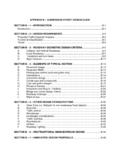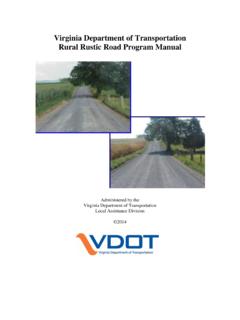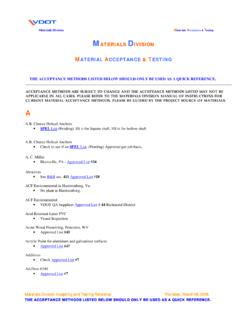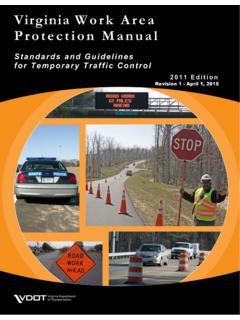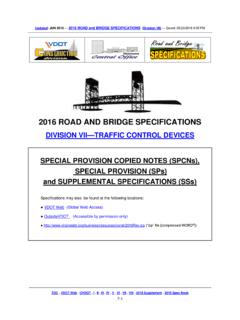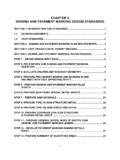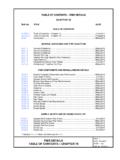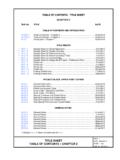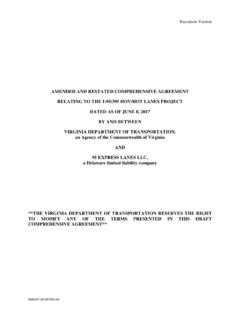Transcription of CHAPTER 1 TRAFFIC SIGNAL DESIGN STANDARDS AND …
1 CHAPTER 1 traffic signal design standards and GUIDELINES SECTION 1: INTRODUCTION .. 1 ACKNOWLEDGMENTS .. 1 SECTION 2: TRAFFIC SIGNAL PLAN REQUIREMENTS .. 2 SECTION 3: VDOT Project Development Process .. 6 SECTION 4: TRAFFIC SIGNAL DESIGN PROCESS .. 7 Step 1 Obtain DESIGN Input Data .. 7 Step 2 Prepare Survey/Base Plan .. 8 Figure 1: TRAFFIC SIGNAL Base Plan Sheet .. 9 Step 3 Perform an Initial Site Visit and Field Verification .. 10 Step 4 Identify TRAFFIC SIGNAL Operation/Lighting Requirements .. 10 Step 5 Review Geometric DESIGN .
2 10 Step 6 Establish Crosswalks .. 10 Step 7 Review Curb Ramp Locations .. 11 Step 8 Establish Stop Lines .. 11 Step 9 Locate Vehicle / Pedestrian SIGNAL Heads and Push Buttons .. 11 Step 10 Locate SIGNAL Poles .. 12 Step 11 Determine Sign Requirements .. 14 Step 13 Locate Vehicle Detectors .. 15 Step 14 Locate Junction Boxes and Conduit Runs .. 16 Step 15 Final Field Visit / DESIGN Verification Meeting .. 16 Step 16 Develop SIGNAL Wiring and Conduit and Cable Legend .. 17 Figure 2: Example Conduit and Cable Legend.
3 18 Step 17 Sizing Conduits .. 18 Figure 3: DESIGN GUIDE FOR CABLE AND CONDUIT SIZING .. 19 Step 18 Detail Mast Arm and Other Poles .. 19 Figure 4: GUIDE TO DETERMINE MAST ARM AND LUMINAIRE ARM .. 20 Step 19 Develop Intersection Specific Details, Legends, Diagrams, Charts and Notes .. 20 Figure 5: SIGNAL POLE/STRUCTURE DETAILS .. 21 Figure 6: SIGNAL HEAD DETAIL .. 22 Figure 7: SIGN DETAIL .. 22 Figure 8: PHASING DIAGRAM .. 23 Figure 9: COLOR SEQUENCE CHART .. 23 VDOT TRAFFIC Engineering DESIGN STANDARDS and Guidelines CHAPTER 1 TRAFFIC SIGNAL DESIGN 1 SECTION 1: INTRODUCTION Currently, the format and information presented on DESIGN plans for TRAFFIC signals owned and operated by VDOT throughout the State can appear significantly different depending on: The year the plan was developed.
4 The VDOT Region where the TRAFFIC SIGNAL will be constructed and operated. The entity designing the plan ( consultants, locality engineering departments, VDOT Region staff, VDOT Central Office staff, etc.) The type of DESIGN project ( a VDOT regional TRAFFIC SIGNAL plan, a DESIGN -bid-build or DESIGN -build DESIGN contracted to a consultant, a TRAFFIC SIGNAL -only construction project or a roadway construction project with TRAFFIC SIGNAL DESIGN plans included, developer project, etc.)
5 Therefore, the purpose of this CHAPTER in the 2014 VDOT TRAFFIC Engineering DESIGN STANDARDS and Guidelines is to establish a consistent and uniform set of guides and STANDARDS for the DESIGN and plan development of VDOT TRAFFIC signals. Statewide uniformity of TRAFFIC SIGNAL plans is intended to improve the overall quality of DESIGN plans, create consistency in the information presented and required on plans throughout the State, and create significant efficiencies in the development and review of VDOT TRAFFIC SIGNAL DESIGN plans.
6 Consistency of plan development will also aid maintenance staff as they address preventative maintenance activities and trouble calls. This document is intended to be a resource for State and local agencies, as well as consulting engineers for DESIGN work in the Commonwealth of Virginia to identify the recommended steps to follow for the development of VDOT TRAFFIC SIGNAL DESIGN plans, as well as provide a set of plan STANDARDS for TRAFFIC SIGNAL designs. It should be noted that each VDOT Regional Operations staff have region-specific DESIGN or equipment preferences that will need to be identified by the designer prior to the start of DESIGN work.
7 However, the format, appearance and information presented on each TRAFFIC SIGNAL DESIGN plan are hereby required to be uniform. ACKNOWLEDGMENTS The following references are used throughout the Section: Latest VDOT adopted version of the FHWA manual of Uniform TRAFFIC Control Devices. The latest version of the Virginia Supplement to the MUTCD. VDOT Guidelines for the Installation of Marked Crosswalks policy issued by VDOT TRAFFIC Engineering Division. VDOT Road DESIGN manual VDOT cadd manual TRAFFIC Detector Handbook (FHWA-IP-90-002) VDOT TRAFFIC Engineering DESIGN STANDARDS and Guidelines CHAPTER 1 TRAFFIC SIGNAL DESIGN 2 SECTION 2.
8 TRAFFIC SIGNAL PLAN REQUIREMENTS VDOT TRAFFIC SIGNAL plans shall follow the STANDARDS described below and shall utilize the symbology, formatting and spacing for plan items as presented in the example plans provided in the Appendix to this CHAPTER and as defined in the VDOT cadd manual utilizing the standard symbology contained in the VDOT TRAFFIC Engineering DESIGN MicroStation Cell Library. In addition, the VDOT cadd manual provides additional information relative to the file management of cadd files used for TRAFFIC SIGNAL DESIGN .
9 Please contact or (804) 786-1280 to obtain the appropriate Microstation files and cell libraries to be used for DESIGN . VDOT TRAFFIC SIGNAL plans use a combination of Engineering (MicroStation Font 3) and Italics (MicroStation Font 23) fonts. Text sizes are based on the drawing scale. Generally, for legibility purposes, the minimum text size is 1/8 . The MicroStation text size for scales may be computed by dividing the drawing scale by 8 [For example, a 25 Scale drawing should have a minimum text size of (25 / 8 = )].
10 Title text should be approximately 3/16 . The MicroStation title text size for scales may be computed by multiplying the drawing scale by 3 and dividing by 16. A majority of text notes, legends, and call-outs are included in the VDOT TRAFFIC DESIGN cell libraries, as described in the VDOT cadd manual . The text size in the cell libraries is based on 25 scale plans. TRAFFIC SIGNAL PLAN SET GUIDELINES: There are several different TRAFFIC SIGNAL DESIGN plan packages that may be required by VDOT, depending on the context of DESIGN being performed.
